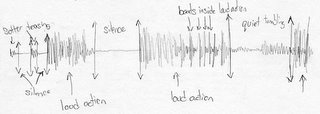Recap-
Timing: How long a move takes. Pose A to Pose B in 10 frames.
Spacing: The nature of the movement inside timing. Slow out—fast in, slow out—slow in, fast out—slow in.
Phrasing: The timing of a given number of moves or actions in combination.
Phrasing is the "music" of animation. Look at the sound waves of Beethoven’s 4th Symphony.

-People/characters are not machines that move to a constant even beat. There are rhythms that people move to but it is not a rhythm that is hit evenly. It is more like something we feel.
-Phrasing is all about changing gears.
Example:
m-o-v-e . . . t-h-e . . . c-h-a-r-a-c-t-e-r . . . s-l-o-w-l-y then fast t-h-e-n . . . s-l-o-w-l-y . . . a-g-a-i-n THEN FAST AND LOUD!
-You can pull the audience in with fast action then pause as the audience anticipates what’s next.
REMEMBER THERE ARE NO RULES
THE WAY YOU DECIDE HOW TO ARRANGE YOUR ACTIONS WITH PHRASING IS TO FIND THE ONE IDEA/POSE/KEY/MOMENT (IN MOTION OR STILLNESS) THAT YOU THINK IS THE MOST IMPORTANT THING IN THE SCENE AND EMPHASIS IT WITH CONTRAST.
How Do You Add Contrast?
-pose
-staging
-complex vs. simplistic
-line of action
-small vs. big
-depth
-squash and stretch
-closed vs. open
Phrasing is MUCH bigger than timing!
Watch how James Baxter uses phrasing with Quasimodo in the Hunchback of Notre Dame. His animation is very simple and doesn’t use complex moves but his phrasing is amazing.
Every character will have their own rhythm or tempo.
Example: Ice Age
Manny the Mammoth à slow and brooding
Sid the Sloth à fast and stupid
How Does This Work Practically?
Example: A man running out of his burning house.
Take the actions/character feelings and write them down as phrases.
Man opens door and runs out of the burning house. The man stops. Remembers his cat. He turns around and runs back into the house.
Now look for similarities and group them together.
Man opens door and runs out of the burning house. The man stops. Remembers his cat. He turns around and runs back into the house.
Remember to emphasis the contrast. Remember to show case the main idea. Look for the key idea of the scene. In this case it would probably be "the man remembering his cat".
Sometimes dialogue does the phrasing for you.
No comments:
Post a Comment